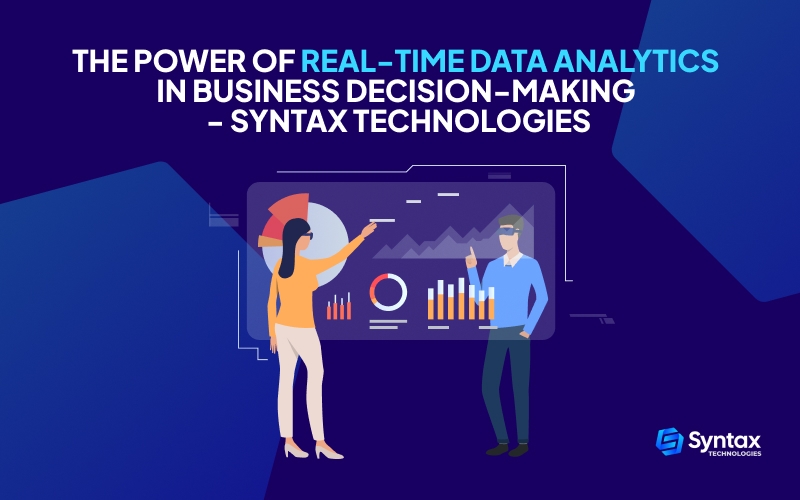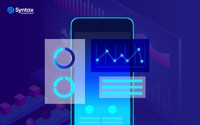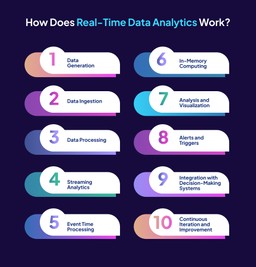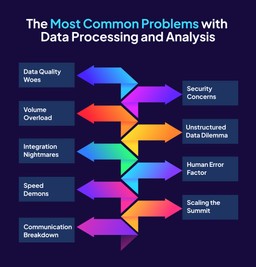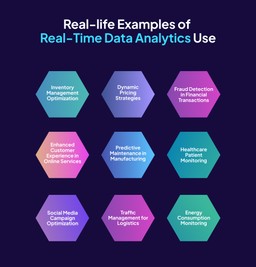Greetings, Data Enthusiast,
If you find joy in deciphering the language of numbers and have an insatiable curiosity about the magic behind data analytics, you’re in for a delightful ride.
Today, we’re delving into the pulsating heart of business intelligence – the world of Real-Time Data Analytics.
Picture this: a landscape where decisions are not mere shots in the dark but well-informed responses to the constant ebb and flow of real-time information.
It’s a world where businesses don’t just react; they anticipate, adapt, and thrive in the ever-changing currents of the market.
And if you can’t help but delve deeper into business intelligence, the best thing you can do is sign up for a data analytics course to get your mental gymnastics running and ready to start your career.
Now it’s time to buckle up because we’re about to explore the profound impact of Real-Time Data Analytics on the very fabric of decision-making!
What is Real-Time Data Analytics?
Alright, fellow data explorer, let’s demystify the buzzword: “Real-Time Data Analytics.”
Imagine your traditional analytics process as a snapshot captured in time ? insightful but static. Now, sprinkle in a bit of magic dust, and voila! You’ve got real-time data analytics, a dynamic and ever-evolving approach to understanding information.
In essence, real-time data analytics is the art of processing and analyzing data the very moment it becomes available. It’s like having a live feed of your business’s heartbeat, allowing you to make decisions not based on yesterday’s news but on the unfolding story of the present.
Think of it as upgrading from a map to a GPS system. With real-time analytics, you’re not just looking at where you’ve been; you’re navigating the twists and turns of the road as they happen.
This handy approach enables businesses to respond promptly to changing circumstances, seize opportunities as they arise, and stay ahead in the fast-paced dance of the market.
How Does Real-Time Data Analytics Work?
Real-time data analytics is a dynamic process that involves capturing, processing, and analyzing data as it is generated, allowing for immediate insights and timely decision-making.
Here’s a simplified breakdown of how real-time data analytics works:
Data Generation:
The process begins with the generation of data. This data can come from various sources, including sensors, devices, social media, customer interactions, transactions, or any other source producing real-time information.
Data Ingestion:
Once generated, the raw data needs to be ingested into a system capable of handling real-time analytics. This involves collecting and transferring the data from its source to a central platform or database in near real-time.
Data Processing:
The ingested data undergoes processing to clean, transform, and structure it for analysis. This step may involve filtering out irrelevant information, handling missing or erroneous data, and converting the data into a format suitable for analysis.
Streaming Analytics:
Real-time analytics relies heavily on streaming analytics, which involves processing data in motion rather than at rest. Streaming platforms allow for continuous data analysis as it flows through the system, enabling instant insights and responses.
Event Time Processing:
Real-time analytics systems often take into account the event time ? the time at which an event occurred in the real world. This is crucial for maintaining the temporal context of the data and ensuring that analyses reflect the most recent information.
In-Memory Computing:
To achieve the speed required for real-time analytics, many systems use in-memory computing. This involves storing and processing data in RAM (random-access memory) rather than on disk, significantly reducing latency and enabling rapid access to information.
Analysis and Visualization:
The processed data is then subjected to various analyses, including statistical algorithms, machine learning models, and other analytical techniques. Visualization tools can be employed to represent the insights in a comprehensible format, aiding decision-makers in understanding the information quickly.
Alerts and Triggers:
Real-time analytics systems often incorporate alerting mechanisms. These triggers can be set up to notify relevant stakeholders or systems when specific conditions or thresholds are met, enabling immediate responses to critical events or opportunities.
Integration with Decision-Making Systems:
The final step involves integrating the insights derived from real-time analytics into decision-making processes. This integration could be with other business intelligence tools, dashboards, or even automated systems that act based on predefined rules or conditions.
Continuous Iteration and Improvement:
Real-time data analytics is not a one-time process. It involves continuous iteration and improvement. Analytical models may need to be updated, and the system must adapt to changes in data patterns and business requirements over time.
In summary, real-time data analytics is a complex interplay of technologies and processes designed to turn raw data into meaningful insights swiftly.
From the moment data is generated to the visualization of actionable results, the goal is to empower businesses to make timely and informed decisions in a rapidly changing environment.
Now that you know what “real-time” means, let’s understand how processing your data on the spot can help make efficient business decisions.
What Are The Most Common Problems with Data Processing and Analysis?
Ah, the challenges of wrangling and taming the data beast! As any seasoned data explorer will tell you, the path to actionable insights is often peppered with hurdles.
Let’s shine a light on some of the most common problems encountered in the realm of data processing and analysis:
Data Quality Woes
The age-old saying holds true: garbage in, garbage out. Inaccurate, incomplete, or inconsistent data can throw a wrench into the smooth machinery of analysis, leading to skewed results and unreliable conclusions.
Volume Overload
The sheer volume of data generated daily can be overwhelming. Managing and processing colossal datasets can strain even the mightiest of computational resources, causing delays and bottlenecks in the analysis pipeline.
Integration Nightmares
Data often resides in different formats, sources, or systems. Bridging the gap between these diverse data islands can be a formidable challenge, requiring meticulous integration efforts to ensure a coherent and comprehensive view.
Speed Demons
Slow processing speeds can be a significant headache in a world where decisions are made in the blink of an eye. Real-time analytics demands nimble processing capabilities, and laggy systems can hinder timely insights.
Security Concerns
With significant data comes great responsibility. Ensuring the privacy and security of sensitive information is a perpetual concern. A breach jeopardizes data integrity and can severely affect trust and compliance.
Unstructured Data Dilemma
The rise of unstructured data, like text, images, and videos, presents a challenge. Extracting meaningful insights from these non-traditional formats requires advanced techniques, often complicating the analysis process.
Human Error Factor
Even the most advanced algorithms can’t escape the occasional typo or oversight. Human error, whether in data entry or analysis, remains a lurking adversary that diligent validation and quality control measures aim to combat.
Scaling the Summit
As businesses grow, so does the magnitude of their data. Scaling up analytical processes to accommodate increasing data volumes without sacrificing performance is a perpetual concern.
Communication Breakdown
Effective communication of findings is as crucial as the analysis itself. Misinterpreting or inadequately conveying results can lead to misguided decisions, rendering the entire analytical effort moot.
Navigating the labyrinth of data processing and analysis requires a combination of technical prowess, strategic thinking, and a dash of creativity.
As we forge into the data-driven future, addressing these challenges head-on is critical to unlocking the true potential of the insights within our data troves.
9 Real-life Examples of Real-Time Data Analytics Use
According to a 2022 report, 80% of businesses are reaping the benefits of real-time data analytics.
Now, that’s a lump percentage.
So, let’s dive into the tangible ways real-time data analytics can transform decision-making in the business world and make things more efficient:
Inventory Management Optimization
In the retail sector, real-time data analytics can track inventory levels, monitor product demand, and predict trends. This enables businesses to adjust stock in real-time, preventing overstock or stockouts, optimizing shelf space, and ultimately improving overall supply chain efficiency.
Dynamic Pricing Strategies
E-commerce giants leverage real-time analytics to adjust pricing dynamically based on factors like demand, competitor pricing, and market conditions. Airlines, for instance, can modify ticket prices in real-time, maximizing revenue during peak demand periods.
Fraud Detection in Financial Transactions
Financial institutions use real-time analytics to detect anomalies and patterns associated with fraudulent transactions. The system can trigger alerts or even halt transactions instantly, preventing financial losses and protecting the business and its customers.
Enhanced Customer Experience in Online Services
Streaming services and online platforms use real-time data analytics to understand user behavior instantly. This insight allows for personalized content recommendations, targeted advertising, and improvements to the overall user experience based on real-time feedback.
Predictive Maintenance in Manufacturing
Manufacturing plants employ real-time analytics to monitor equipment and machinery. By analyzing data on the fly, businesses can predict when equipment will likely fail, schedule maintenance proactively, and minimize downtime, thereby improving overall operational efficiency.
Healthcare Patient Monitoring
In healthcare, real-time data analytics is crucial for monitoring patient vitals. It enables healthcare professionals to receive instant alerts about critical patient condition changes, facilitating timely interventions and improving patient outcomes.
Social Media Campaign Optimization
Marketing teams utilize real-time analytics to track the performance of social media campaigns. By monitoring engagement metrics, sentiment analysis, and audience behavior in real-time, businesses can adjust their strategies on the fly, maximizing the impact of their campaigns.
Traffic Management for Logistics
Logistics companies leverage real-time data analytics to optimize routes and manage traffic conditions. This ensures timely deliveries and reduces fuel costs and environmental impact, contributing to a more sustainable and efficient supply chain.
Energy Consumption Monitoring
Industries and intelligent buildings use real-time analytics to monitor energy consumption.
By analyzing data on electricity usage, businesses can identify opportunities to optimize energy efficiency, reduce costs, and minimize environmental impact.
In these real-life scenarios, the immediacy of real-time data analytics empowers businesses to make informed decisions, adapt to changing conditions, and gain a competitive edge in their respective industries.
It’s a powerful tool that enhances operational efficiency and unlocks new possibilities for innovation and growth.
How to Get Started with Real-Time Data Analytics
- Define Your Career Objectives:
Start by outlining your career goals and the specific areas of data analytics that interest you. Understanding your personal objectives will guide your skill development and analyst job search strategy.
- Familiarize Yourself with Real-Time Data Analytics Tools:
Explore the data tools commonly used in real-time data analytics. Get hands-on experience with platforms such as Apache Kafka for data streaming or Apache Spark Streaming for real-time data processing.
- Learn Data Ingestion Techniques:
Dive into the techniques of ingesting data in real-time. Understand how connectors, APIs, and other ingestion tools work. Familiarize yourself with how platforms like Apache Kafka facilitate the flow of data.
- Master Streaming Analytics Tools:
Acquire proficiency in streaming analytics tools like Apache Flink or cloud-based solutions like Amazon Kinesis Analytics. Learn to write SQL queries to analyze data in real-time.
- Explore In-Memory Computing:
Understand the concept of in-memory computing and its significance in real-time data analytics. Consider exploring tools like Apache Ignite or Redis to grasp how data is stored and retrieved rapidly.
- Gain Skills in Data Visualization and Reporting:
Develop skills in data visualization tools like Tableau or Power BI. Learn how to create engaging and informative visualizations that can communicate insights effectively.
- Understand Machine Learning Integration:
If interested in machine learning, explore how to integrate models into a real-time analytics pipeline. Familiarize yourself with tools such as TensorFlow or Scikit-Learn and their application in data analysis.
- Learn about Monitoring and Alerting:
Grasp the importance of monitoring tools in real-time data analytics. Understand how alerts can be set up to detect anomalies or issues that require immediate attention.
- Explore Data Governance and Security:
Gain insights into data governance and security measures within the realm of data analytics. Understand how businesses ensure compliance and protect sensitive information.
- Continuous Skill Development:
Recognize that the field of data analytics is ever-evolving. Commit to continuous learning and skill development to stay abreast of emerging technologies and methodologies.
- Seek Training Opportunities:
Enroll in training programs or consider pursuing certifications that enhance your proficiency in real-time data analytics tools and techniques.
- Build Practical Experience:
Start small by working on personal projects or contributing to open-source initiatives. Building a portfolio of practical experiences will enhance your attractiveness to potential employers.
By following these steps tailored to a career-focused perspective, you can equip yourself with the skills and knowledge needed to pursue a role as a data analyst in a business setting.
Remember to showcase your practical experiences and continuously refine your skill set as you progress in your career journey.
Navigating the World of Real-Time Analytics with Syntax Technologies
Whether you’re venturing into the world of data analytics as a newcomer or an aspiring data analyst, the realm of real-time data analytics holds incredible potential.
It’s not merely about numbers; it’s about unlocking the secrets within the data flow to make informed decisions and stay on the cutting edge of this dynamic field.
As we’ve explored the tools, technologies, and strategies to dive into real-time data analytics, remember that this journey is a continuous learning process.
For those eager to embark on this journey, Syntax Technologies offers a comprehensive business intelligence and data analytics course. This learning opportunity is designed to equip you with the skills needed to navigate the fascinating realm of real-time data analytics.
Here’s to your journey of discovery, empowerment, and the excitement of translating data into impactful decisions!
